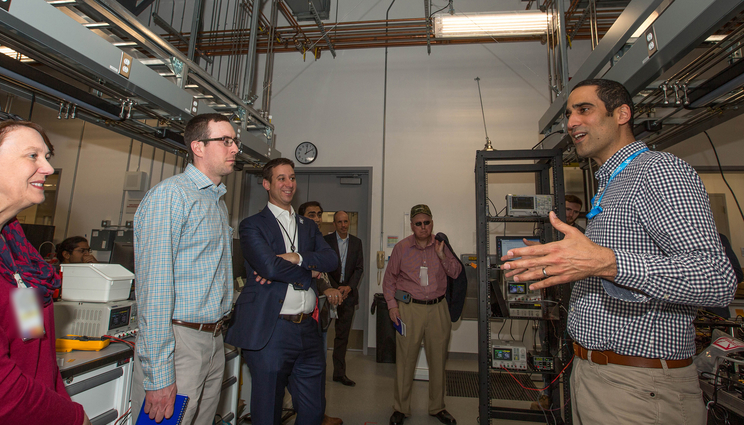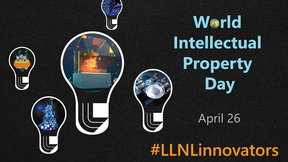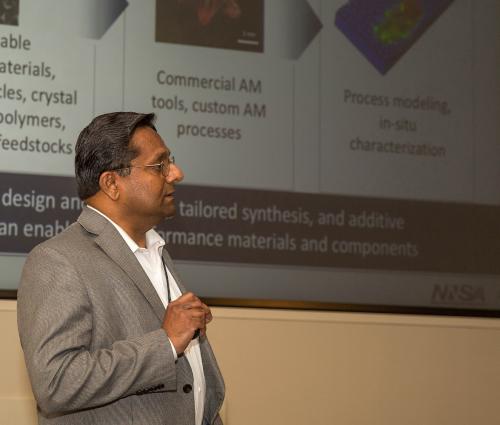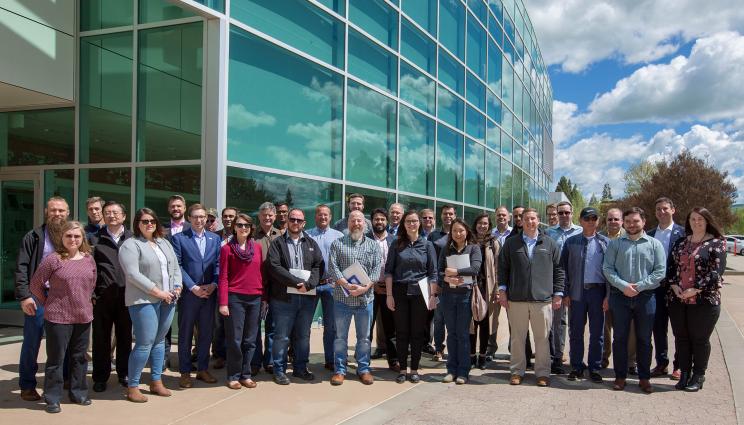LLNL hosts DOE's 2019 Better Plants Technology Days to spur industry partnerships
 (Download Image)
Speaking to visitors at the Advanced Manufacturing Laboratory, Vector Atomic CEO Jamil Abo-Shaeer discusses how his company has been able to utilize technology developed at the Lab as well as its facilities, equipment and expertise to advance its atomic-based geolocation devices and grow the company. Photos by Julie Russell/LLNL
(Download Image)
Speaking to visitors at the Advanced Manufacturing Laboratory, Vector Atomic CEO Jamil Abo-Shaeer discusses how his company has been able to utilize technology developed at the Lab as well as its facilities, equipment and expertise to advance its atomic-based geolocation devices and grow the company. Photos by Julie Russell/LLNL
Officials from the Department of Energy’s Office of Energy Efficiency and Renewable Energy (EERE) joined representatives from more than two dozen private companies in visiting Lawrence Livermore National Laboratory (LLNL) on April 9 for the 2019 Better Plants Technology Days.
The annual event, hosted this year at LLNL and Lawrence Berkeley National Laboratory, is aimed at exposing partners of DOE’s Better Plants program to the potential benefits of technologies developed at the DOE national labs and encouraging future public-private partnerships. Through Better Plants, which boasts more than 200 industry partner organizations, DOE works with manufacturers, water and wastewater treatment plants and other industries to reach long-term energy reduction goals and improve competitiveness.
Technology Days kicked off with a welcome from EERE Chief of Staff Alex Fitzsimmons and an overview of the Laboratory presented by LLNL’s Deputy Director for Science and Technology Pat Falcone. In his first visit to the Laboratory, Fitzsimmons said he was looking forward to learning about projects Lab scientists and industry professionals were working on and how EERE could help advance them.
"Manufacturing competitiveness is one of the top priorities for the Trump administration, and we just love the Better Plants program. It’s a voluntary program, there’s very little cost to taxpayers but very high returns for all the companies that are involved," Fitzsimmons said. "I think it’s fantastic that we have the private sector, the public sector, the national labs and government all coming together to showcase what we can all do to advance domestic manufacturing."
Lab managers, scientists and group leaders then highlighted Lab capabilities and emerging technology in materials and manufacturing, high-performance computing and modeling, water management and cyberdefense. LLNL’s Associate Director for Engineering Anantha Krishnan described Lab breakthroughs in advanced manufacturing that could impact the commercial sector, including novel micro-architected and hierarchical materials and advancements in 3D printing processes such as two-photon lithography, large area projection micro-stereolithography, direct ink writing, diode-based additive manufacturing and volumetric printing.
"In the future, we hope many of these technologies will be enhanced to maturity through the public-private partnerships that we will establish in the Advanced Manufacturing Laboratory (AML)," Krishnan said.
The AML, which opened in the Lab’s Livermore Valley Open Campus in 2018, allows Lab scientists to work shoulder-to-shoulder with private companies in an open environment. Following Krishnan, Materials Engineer Division Leader Diane Chinn discussed how Lab missions have pushed advanced manufacturing technologies, such as precision engineering, microfabrication, carbon fiber composite materials and neural implants. Advanced Manufacturing Group Leader Alex Hamza talked about how advanced manufacturing has been used for Lab missions, including 3D printed target fabrication for the National Ignition Facility.
The talks moved on to the role of high-performance computing (HPC) modeling and simulation in manufacturing. LLNL computational engineer Saad Khairallah discussed using the ALE3D code to simulate the complex physics involved in laser powder-bed fusion additive manufacturing (metal 3D printing) and how the simulations have been used to reduce defects in printed parts.
"We are a science lab, but also we are a manufacturing lab," Khairallah said. "Behind the scenes there are indications that we’re at the doorstep of the next industrial revolution, which is dubbed Industry 4.0. History teaches us that all nations that adopt technology early on create benefits for their societies, and AM is promising to be this next big thing."
Continuing the thread of HPC’s impact, LLNL senior scientist Victor Castillo discussed the role of artificial intelligence and machine learning in improving manufacturing processes, such as those found in molten glass tank furnaces, though the HPC4 Manufacturing program (HPC4Mfg). Operators also may benefit from a soon-to-be open source code called Merlin that can be used to make real-time predictions of process parameters, Castillo said. Computational Design Optimization lead Dan Tortorelli then explained how HPC and Livermore Design Optimization (LiDO) software is being used to create new architectures and optimize material performance, with possible implications for metamaterials, batteries, microreactors, flow batteries and electrochemical reactors.
Following the morning’s talks, Better Plants partners and EERE guests took tours of the Advanced Manufacturing Laboratory, the National Ignition Facility, the High Performance Computing facility, the Fiber Draw Tower and the Modular and Sustainable Supercomputing Facility. The AML currently has eight industry partnerships, and one startup has already taken up residence in the building, Vector Atomic, which is working to commercialize atomic-based devices for geolocation when standard GPS is compromised or unavailable.
Vector Atomic’s CEO Jamil Abo-Shaeer told visitors how his company has been able to utilize technology developed at the Lab as well as its facilities, equipment and expertise to advance the devices and grow the company. Visitors also heard from Lab engineer Will Smith about the commercialization of Lab-developed microcapsules for carbon capture and cleaning CO2 from the air in homes and office environments using algae, the latter a partnership with a private company called ArtVeoli.
To conclude the visit, attendees heard from Lab experts in water management, water deionization and cyberdefense, and learned about the logistics of collaborating with the Lab. Lab and EERE officials said they anticipated the event would serve as an introduction to industry about Lab-developed technologies they could benefit from and catalyze ideas for future partnerships.
"For the companies it gives them exposure to what the Lab is working on," said Patrick Dempsey, director of strategic engagements in Engineering and part of the event’s technical committee. "From the Lab’s perspective there are two benefits; the potential for commercialization of technology and more importantly, finding partners in industry that have similar objectives and can accelerate our development of mission-critical technologies."
"You can hear about all the great things that the national labs do, but it doesn’t really compare to being able to go out and see them in person," said event organizer Eli Levine, program manager for EERE’s Advanced Manufacturing Office. "We’ve seen some really interesting partnerships come out of the previous Technology Days, and when you get smart people in a room together, good things tend to happen. Getting industry to leverage the resources of the Lab and partner with their facilities is very much a priority for us."
Technology Days was hosted by LLNL’s Innovation and Partnerships Office Director Rich Rankin. In addition to Dempsey, the technical committee included High Performance Computing Innovation Center Deputy Director Wayne Miller (lead) and Market Outreach Manager for Strategic Engagements Jim Bono.
Contact
 Jeremy Thomas
Jeremy Thomas
[email protected]
(925) 422-5539
Related Links
Industrial Partnerships at LLNLTags
HPC, Simulation, and Data ScienceHPC Innovation Center
Industry Collaborations
Livermore Valley Open Campus
Technology Transfer
Science
Featured Articles









